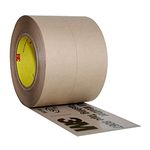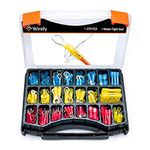The Not So Stupid Show House
Most show houses are stupid. They’re chest-pounding testaments to their designers’ egos and their sponsors’ pocketbooks. Touring a typical show house is like walking the midway at a busy carnival. Every person and every product screams for your attention, hardly the makings of a good house.
I thought all show houses were stupid until I visited one designed by Sarah Susanka at the 2004 International Builders’ Show in Las Vegas. A contributing editor to Fine Homebuilding and the author of the best-selling book The Not So Big House, among others, Sarah based the show-house design on a house of hers that we had published the year before (FHB #156). Consequently, thousands of people actually got to tour a house by one of our country’s best architects. The open floor plan was thoughtful, with ceiling heights defining the spaces. The detailing was subdued, but it unified the house and created a sense of calm. The only major failing was that this house didn’t fit its site very well. But perhaps that’s forgivable when you consider that the house was built in the parking lot of the Stardust Hotel.
Despite the hassles of building a show house, Sarah is doing it again at the 2005 International Builders’ Show in Orlando, Fla., which runs Jan. 13-16 (www.buildersshow.com). She’s teaming up with building-science consultant Steve Easley (who also was involved last year) and green-building expert Ron Jones. The principal sponsors are the U.S. Department of Energy; the Green Building Subcommittee of the NAHB’s Construction, Codes and Standards Committee; and the Sustainable Buildings Industry Council. And this time, the house will be built on a real site, just outside Orlando.
The Not So Big Showhouse will embody the design principles that Sarah espouses in her books, mainly that “comfort has almost nothing to do with how big a space is. It is attained, rather, by tailoring our houses to the way we really live.” Combine this sensibility with a commitment to sustainability and energy efficiency, and you’ve got the recipe for a great house. I hope you can make the trip to Orlando to see for yourself. To learn more about the show house, go to www.notsobigshowhouse.com.
—Kevin Ireton, editor
Half pedestal, half vanity
I enjoyed Lynn Hopkins’s excellent article on sinks and storage in small bathrooms (FHB #164, “Drawing Board,” pp. 120, 122, 124). I too am a fan of pedestal sinks, but I want to remind people that there’s also an option between pedestal and vanity that I’ve grown fond of in recent years: partially encased sinks. The one in the photo is from Porcher (www.porcher-us.com). Typically, the sink sets into a cabinet that’s about 12 in. deep, which is deep enough for storage and yet not so big as to crowd the room.
—Robert T. Coolidge, Branford, Conn.
Plywood stiffens walls
I was never satisfied with the flimsy nature of pocket-door split studs (FHB #166, pp. 74-77), but then I discovered that attaching full-height pieces of 5⁄8-in. or 3⁄4-in. plywood to the drywall (prior to installing it) added significantly to the strength and rigidity of the finished wall. The plywood is attached to the drywall with screws and adhesive and fits between the split studs when the drywall is installed. The plywood also provides firm backing for attaching towel bars when used in a bathroom.
—Randy Rogers, via email
Beware electrification
In my town, a shed smaller than 8 ft. by 12 ft. doesn’t require a permit if it has no power or plumbing, but one with power requires a building permit, regardless of size. So an innocent desire to add lights to a shed (FHB #166, pp. 72-73) could result in the need to get the whole building permitted.
—Bill Houghton, Sebastopol, Calif.
An alternative to rakes
In your August/September issue (FHB #165), the article “A New Lawn Completes Any Building Project” included a photograph on p. 95 captioned “Rake in the seed.” It reminded me of the time when I once, and never again, put in a yard.
After all the days of preparation in a horridly hot, dry June in Michigan, I finally was faced with the task of walking up and down the newly seeded yard with just one rake. Looking over this wide expanse of dry, dusty, sunbaked earth, I thought: “There has to be a better way.” With that thought, I went to the garage to look for something, anything, to make this last task easier.
While rummaging, I happened on an old set of tire chains. My eyes grew wide, and my sprits were buoyed. I attached them to a 2×2 that was just a bit longer than both of the chains end to end (overlapped in the middle), and then tied a piece of nylon rope to the ends of the 2×2.
With my new tool, I was finished dragging the yard and setting the seed in no time, and was I overjoyed.
—W.R. Wooley, Old Saybrook, Conn.
Coping-saw advice from the U.S. Navy
In the June/July issue (FHB #164, “Building Skills,” p. 116), Tom O’Brien states that when installing a coping-saw blade, “make sure the teeth face forward (the same as a standard handsaw).” But the Bluejackets’ Manual (the United States Navy, circa 1940) taught me that fine-blade saws such as coping saws and hacksaws should have blades installed to cut on the pull stroke. This advice has served me well all these years. Using this installation method, I almost never jam or break a blade.
—William Andors, Englewood, Fla.
Bridging prevents a bouncy floor
In response to Thor Matteson’s “Correcting a bouncy I-joist floor” (FHB #166, “Q&A,” p. 104), I would like to add my firm’s own experience with a bouncing I-joist floor.
We designed a house where the clear span over the kitchen was 17 ft. The master bedroom was directly above the kitchen. After moving in, the owners complained of floor bounce, sound transmission, and lightfixture vibration at the ceiling in the kitchen.
We had specified 117⁄8-in. TJI, 250-series I-joists at 16 in. on center with bridging at the onethird points. The I-joist manufacturers suggest enhanced floor performance when bridging is installed.
Once on the job site, we opened a probe within one joist cavity. As we had suspected, the contractor did not install the bridging. (I’m not certain why, but a large percentage of contractors resist installing the bridging.)
In this instance, we required the 1⁄2-in. drywall ceiling to be removed. We specified bridging installed at the one-third points. In addition, we added 3⁄4-in. plywood web stiffeners at each joist, one side only. Finally, we specified full-depth sound attenuation batts for each joist cavity, sealed with 1⁄2-in. drywall, glued and screwed to the bottom of the floor assembly.
The owners were thrilled with the results.
—John A. Liggero, Oakland, N.J.
PVC conduit is cheap insurance
I applaud Joseph Truini’s encouragement to run power to an outbuilding (FHB #166, pp. 72-73). Who knows why more people don’t. However, he recommends direct-burying 12-2 UF wire; I’d strongly urge using PVC conduit for the full length of the run. This is cheap insurance against someone slicing unprotected direct-buried wire with a spade or tiller. I’ve done both. Fifty ft. of 3⁄4-in. conduit costs less than $10. But when I run power to outbuildings, I like to oversize, to allow space in the tube for more wire later for a second circuit or even for 220. Fifty ft. of 1-in. PVC conduit will run you about $12, and a like amount of 11⁄4-in. about $15. Using “bell-end” conduit and 90º sweeps, you avoid messing with couplings and other fittings.
Second, why dig a 4-in. trench for a 1-in. conduit? These days, electricians and landscape companies installing irrigation pipes prefer smaller trenchers that cut a 2-in. ditch. They’re much easier to handle, make much less of a mess of the yard, and rent at The Home Depot for $49 for four hours, compared to $118 for the heavy-duty machine that Mr. Truini used.
—John G. Fox, Bainbridge Island, Wash.
Joseph Truini replies: You’re right, running the cable through conduit would offer more protection against accidental damage, depending, of course, on the source of the damage. For example, conduit won’t stop a backhoe or a tiller.
As for trenching machines, the 4-in. machine was the smallest offered by our local rental dealer, who delivered and picked up the machine, a service not offered by The Home Depot.
Maybe the Greeks just got lucky
Please forgive my nitpicking. Certainly you have more relevant concerns than foolish questions of historical accuracy. But just in case you are interested, Carolyn Murray has fallen into a trap by asserting that both the Egyptians and the Greeks used the golden section in their architecture (FHB #166, “Drawing Board,” pp. 128, 130, 132). Although similar claims have been made for centuries, the evidence is compelling that the Egyptians did not use the golden section, and there is seemingly little evidence that the Greeks did.
But please, make up your own mind. Look no further than the diagram of the Parthenon outlined by the golden section (p. 132). Have a careful look at the edges of the rectangle. Do the borders fall on strong architectural features, or are they instead drawn arbitrarily floating in space?
There is no doubt some strong psychological pull at work that has compelled “golden numberists” for centuries to try and fit various architectural wonders into the golden rectangle. But modern evidence points more to wishful thinking than historical fact. For a good read and much more about the golden section, try The Golden Ratio: The Story of Phi, the World’s Most Astonishing Number by Mario Livio (Broadway, 2002).
—Charlie Ruppert, Berkeley, Calif.
Fine Homebuilding Recommended Products
Fine Homebuilding receives a commission for items purchased through links on this site, including Amazon Associates and other affiliate advertising programs.

Handy Heat Gun

8067 All-Weather Flashing Tape

Reliable Crimp Connectors






















